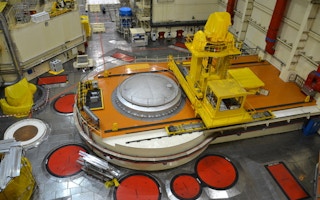Nuclear reactors that will fit on the back of a truck are the great new hope for nuclear industry expansion.
These small modular reactors (SMRs) are being backed by the US, China and the UK as part of a low-carbon electricity strategy to deploy alongside renewables.
Several manufacturers are designing and building prototype reactors that are similar to the power providers for icebreakers and nuclear submarines. They vary in capacity up to 30 megawatts − enough to produce enough electricity for a small town.
All the major manufacturers, electricity suppliers, regulators and some enthusiastic politicians will attend an SMR summit in London for two days from October 20, with the aim of getting the reactors from the design and development stage to widespread deployment.
Critical time
The push to develop SMRs comes at a critical time for the nuclear industry as the building of traditional large nuclear power stations is increasingly marked by cost over-runs and delays.
They are also seen as out of step with modern grids, where small-scale renewables close to the point of use are beginning to dominate.
The idea of SMRs is that they can fit the modern pattern and be deployed close to population centres where the power is needed, so avoiding the 10 per cent power loss from large reactors that is inevitable because of the vast distances the power is transmitted.
In most countries, safety and the need for large quantities of cooling water dictate that traditional large nuclear power stations are sited on the coast, or in remote places isolated far from big towns and cities.
The UK’s National Nuclear Laboratory, a government body, believes there is vast potential for SMRs, estimating that they could provide 65-85 gigawatts of new electricity production by 2035, valued at £250-£400 billion (about US$400-615 bn) of business.
If this estimate is anywhere near accurate, this would mean around 3,000 small reactors being deployed worldwide in the next 20 years.
Gordon Waddington, of Rowan House consultants, will chair the London meeting. He was formerly a leading engineer with Rolls-Royce, is an expert on the nuclear industry, and believes that SMRs are vital in combating climate change.
Despite this, he says that there are considerable technical problems in the UK over the deployment of SMRs, with regard to meeting safety and security requirements − including the safeguarding of nuclear materials − while keeping the power produced at an economic price.
The price tag of £1bn-2bn per reactor is well below the £24 billion for current large reactors, but is still a considerable outlay for an as yet untried technology. “It would take a significant leap of faith for any utility to build the first reactor,” Waddington says.
There are also other problems, such as getting local approval for siting the reactors, and getting agreement on prices for the electricity.
However, Waddington also sees it as a “once-in-a-generation opportunity” to get involved in an industry as it takes off, and for a country like the UK to develop SMRs for the domestic market and also for export.
He says: “The next two or three years will be critical in development if small modular reactors are to be deployed extensively in the next 10 years.”
Amber Rudd, the UK government’s Energy and Climate Change Secretary, who has reduced wind and solar subsidies, is keen to underwrite the nuclear industry.
At the governing Conservative party’s annual conference this week, she praised the work of Sheffield University’s Nuclear Advanced Manufacturing Research Centre, and specifically its work on the next generation of SMRs.
Cost to consumers
However, she also revealed that the UK is reviewing its energy policy, which means that support for nuclear − with the extra cost to consumers it will involve − might not be acceptable when wind and solar are already much cheaper, and when electricity demand in the UK is going down.
So far, however, politicians and the nuclear industry keep repeating the myth that the UK’s existing nuclear stations are going to close down in the next decade.
George Osborne, the UK chancellor, last week gave this as the main reason for his government offering a £2 billion loan guarantee to the Chinese if they will help new nuclear construction in Britain.
This is despite the fact that the French company EDF, which owns all but one of Britain’s nuclear stations, has a policy of investing in the old stations and seeking five-year extensions in the lifetimes of all its reactors – in one case, for 20 years.
Some have already been granted extensions and, under British regulations, these extensions could be repeated every five years for decades, provided the reactors remain safe.










